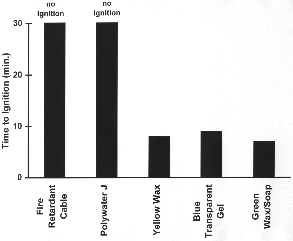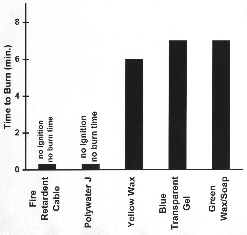| |
|||||||||
| |
|
|
|
|
|
|
|
||
| Home | About | Literature | Site Map | MSDS | Contact | Engineers | Shows | Links | Samples | RFQ | Catalog Numbers |

The National Electrical Code requires both communications cable and electrical cable to meet fire-resistance requirements, depending on location. A primary objective of design engineers continues to be the prevention of fire spread through cabling systems. This "Technical Talk" will review the combustion properties of a sometimes ignored cabling system component--one that can be almost as continuous in a system as the cable itself--the residue from the cable pulling compound.
Where & Why
Cable pulling compounds (or lubricants) are specialty materials that reduce cable jacket friction against conduit, thus lowering the tension on cable as it's pulled into conduit. In the world of cable installation, it is often not practical to install cables without a good pulling lubricant. The potential damage to the cable from excess tension, the extra splices from short runs, the equipment wear and safety hazard from high tension ropes . . . all dictate the use of a high-performance pulling compound for lower cable pulling tension.
An effective cable pulling lubricant "clings" to cable jacket, and is ultimately continuous throughout a duct system. In fact, to be effective, the lubricant must be present at all the surfaces where the cable rubs. A common way to lubricate is to apply lubricant continuously to cable as it enters conduit. Optional methods involve "swabbing" the conduit or spreading the lubricant in front of the cable as it is pulled. Regardless of the application method, effective lubrication results in lubricant (and eventually, lubricant residue) throughout the conduit.
Chemical Building Blocks
Field installers tend to call all pulling lubricants "soaps." Actually, commercial pulling compounds vary significantly in their makeup. The most common lubricants are emulsions (or solutions) of hydrocarbon waxes, glycol oils, high molecular weight polymers, silicone oils, and . . . yes . . . even some soaps (saponified fatty acids). Good pulling lubricants are not simple, single component systems. They contain numerous ingredients to control viscosity, drying speed, stability, wetting character, freezing point, and even scent!
These emulsion (or solution) lubricants all have an "evaporating" phase, which is usually mostly water. After use, the lubricant slowly dries. The residue left after this drying is what may be exposed to heat and flame in a fire situation.
How Large is the Pile?
Lab tests show that lubricant residues not only vary in appearance and chemical nature, but also in amount!! The amount can be measured as "percent solids," which is the weight of dried residue as a percent of the original lubricant weight. Percent solids for several popular pulling lubricants are presented in Table 1:
| PERCENT SOLIDS DATA | |
|---|---|
| Lubricant | % Solids |
| Polywater® J | 3.5 |
| Yellow Wax | 14.0 |
| Blue Transparent Gel | 11.2 |
| Green Wax/Soap | 12.3 |
We see that the amount of residue in the conduit will vary significantly by lubricant . . . by a factor of four or more! The "amount of residue" (or fuel) is one factor in combustion performance.
However, as you might suspect, the chemical nature of the residue is the most important factor in combustibility. How can we measure this combustion behavior of lubricant residues in a way relevant to the potential fire exposure?
Non-Combustible Confusion
Most all cable lubricant manufacturers advertise their products as "non- combustible" and "non-flammable." Isn't this enough? What does it mean? Generally, these words are used as defined in shipping regulations; i.e., "Flammable Liquid" with a TCC Flashpoint between 100° and 200°F.
Unfortunately, flashpoint testing is intended to assess explosion hazard from solvents. Flashpoints are not meaningful for determining lubricant residue combustion character. Cardboard and candlewax are "non-combustible" using the flashpoint criteria above. Something better than flashpoints is needed to determine combustion properties of lubricant residues.
Fire Exposure Assessment
Lubricant residue exposure in a fire is very similar to cable exposure. To illustrate, consider what happens when an outside fire heats conduit (and lubricant residue). The residue warms, sputters, ignites or sizzles, etc. Once the outside heat source is removed, if there is a flame, it either continues to burn and spread or it goes out (self-extinguishes).
Cable flammability standards (IEEE 383; IEC 332; UL 910, 1581, and 1666; etc.) basically simulate the exposure described above. An outside heat source (controlled flame) impinges on cable and ignition is studied. Eventually, the outside flame is extinguished, and observations are made on continuing burn, flame movement, amount of burn, etc.
A paper at the 36th International Wire and Cable Symposium presented a series of lubricant residue fire tests run in the basic style described above. A controlled heat flux (fire intensity) impinged on lubricant residue in a metal conduit. Combustion properties were observed (including ignition time, ignition energy, flame spread, burn time, extinguishing character, etc.). It is beyond this "Technical Talk's" scope to detail all the research, but some of the major findings are discussed below.
Physical Changes on Heating
The first significant finding is that some of the wax-type lubricant residues melt when heated! This highly mobile fluid will gravity-flow; and since these melted waxes are superheated, some spectacular flame-throwing effects occur--spectacular, and highly conducive to spreading fire through a conduit system.
Melting data on some of the lubricant residues tested are presented in Table 2. Note that a fire-retardant (Class 1E) cable jacket is used as both a control and a way to give additional perspective.
| LUBRICANT MELTING PROPERTIES | |
|---|---|
| Lubricant | Fluid at 300°C? |
| Polywater® J | No |
| Yellow Wax | Yes |
| Blue Transparent Gel | Yes |
| Green Wax/Soap | Yes |
| Fire-retardant Cable Jacket | No |
Ignition Properties
Significant differences are found in the time it takes the lubricant residue to ignite, if it ignites at all. Ignition is attempted through exposure to a pilot flame at 30-second intervals. Ignition data are presented in Table 3.
TABLE 3 - LUBRICANT RESIDUE IGNITION TIME AT 42 KW/m² HEAT FLUX

Table 3 shows ignition with an external heat flux of 42 KW/m², a level we might see in a small fire.
If ignition occurs, the length of time the burn continues is measured. These burn-time data are presented in Table 4:
TABLE 4 - BURN TIMES AT 42 KW/m² HEAT FLUX

The samples that ignite burn for a considerable period of time. Additional studies show the dependence of burn time on percent solids (amount of fuel) as mentioned previously. However, as the Polywater® J and Fire-retardant Cable Jacket show, some materials resist ignition and thus have no burn time.
Flame Spread
Only a small section of residue is exposed to the pilot flame, and if it ignites, flame propagation behavior can be observed. Such flame spread is also a factor in burn times. When the flame spreads, the fire burns until all the available residue is consumed. Observations on flame spread are presented in Table 5:
| FLAME SPREAD BEHAVIOR AT 42 KW/m² HEAT FLUX | |
|---|---|
| Lubricant | Flame Spread? |
| Polywater® J | No |
| Yellow Wax | Yes |
| Blue Transparent Gel | Yes |
| Green Wax/Soap | Yes |
| Fire-retardant Cable Jacket | No |
The Big Picture
The full research included a number of heat flux levels and lubricants. The research shows Polywater® J is considerably more fire resistant than all the other lubricants tested, as fire resistant as the cable jacket control. Surprisingly, well over half the lubricants evaluated had melting residues that were quite combustible.
The combustion of lubricant residues is most relevant where fire-retardant cable is used in conduit, and fire propagation is of concern. Lubricant residues affect, and even negate, the self-extinguishing properties of fire-retardant cable. The soundest approach is to require the lubricant residue to be as fire resistant as the cable itself. The research indicates this is possible with Polywater® J (and now with new Polywater® LZ for LSZH/LSHF cables as well).
Unfortunately, the open ladder (tray) fire tests for cables do not work well with cable lubricants. The lubricants' residues melt and drop into the flame before they ignite. Testing must be done in conduit, with lubricant residues, for meaningful results.
Specifications and Additional Information
Copies of the research, fire-test methods, and fire-performance specifications for cable lubricants are available. If you would like to receive these, e-mail or call Customer Service toll free at the number below.
View this article in PDF Format
Click here to view our free streaming video on Cable Installation Engineering
For Subscriptions, Comments, or Questions contact: tkeditor@polywater.com
Home |
About |
Site Map |
Literature |
Samples |
Links |
Reps |
Videos |
Pumps |
RFQ
Codes |
Engineering |
Shows |
Spotlight |
Newsletters |
MSDS |
Translations |
Contacts |
Jobs

11222 60th ST N | Stillwater, MN 55082-9310 USA
1-(651) 430-2270 (Voice) | 1-(651) 430-3634 (Fax)
1-(800) 328-9384 (Toll-Free US/Canada Only)
Copyright © 2001 - 2015 American Polywater Corporation | ![]() 6/5/15
6/5/15